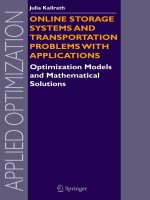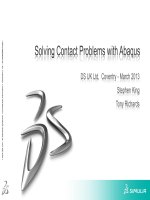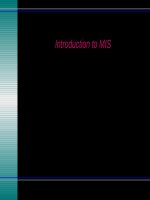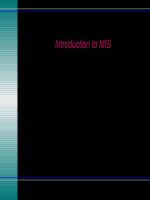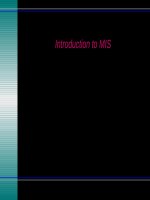Lecture Management information systems: Solving business problems with information technology – Chapter 5
Bạn đang xem bản rút gọn của tài liệu. Xem và tải ngay bản đầy đủ của tài liệu tại đây (1.07 MB, 37 trang )
Introduction to MIS
Chapter 5
Operations and Transactions
Copyright © 1998-2002 by Jerry Post
Introduction to MIS
1
Transactions
Additional
Stores
Bank
Supplier
POS
Terminals/
Registers
Introduction to MIS
Sales Reports
Process Control
Customers
EDI
Central Computer
2
Introduction to MIS
Strategic
Mgt.
Tactical
Management
Business Operations
DS
Tr
S
a
Pr Pr nsa
oc oc c t
es es i on
s C si n
on g
t ro
l
ES
Data Capture
Electronic and Mobile Commerce
Payment Mechanisms
Data Quality
Transactions
The Role of Accounting
HRM and Transaction Processing
Cases: Retail Sales
Appendix: Accounting
EI
S
Outline
3
Data Capture
Point of Sale
Process Control
Electronic Data Interchange
Additional
Stores
CEO Information
Strategy
Bank
Tactics
Warehouse
Inventory
Management
Supplier
Operations
POS
Cash
Registers
Introduction to MIS
EDI
Process Control
Customers
Sales Reports
Central Computer
4
Data Capture: Sales
Collecting transaction data at the point of sale ensures accurate data,
speeds transactions, and provides up-to-the-minute data to managers.
Introduction to MIS
5
Process Control
Various Production machines: lathe, press, dryer, . ..
Control settings
and commands
Production data:
Quantity
Quality
Time
Machine status
Introduction to MIS
Control Terminal
6
Electronic Data Interchange
The price of paper
EDI
$30 to $40 for each purchase order
$24 to $28 for suppliers to handle
$12 for orders
0.32 for suppliers
Proprietary EDI
Commercial providers and standards
Introduction to MIS
7
EDI: Proprietary
Firms must support multiple data
formats and sometimes different
computers for each contact.
Customer 1
Queries &
Orders
Supplier
Introduction to MIS
Co
D nv
if f e
er rt
en d
t f ata
or
m
at
a
at
td
er
nv
Co
Production
Database
& Accounts
Order
Database
& Accounts
Invoices &
confirmation
Customer 2
8
EDI: Standards
Bank/EDI consolidator
Route
Messages
o
t t
r
ve ar d
n
Co and
St
Messages
to/from
any customer
o
t t
r
ve ar d
n
Co and
St Production
Database
& Accounts
Customer 1
Order
Database
& Accounts
to
t
er rd
v
n da
o
C an
St
Customer 2
Supplier
Introduction to MIS
9
EDI Standards
UN Edifact
US ANSI X12
Segments for each area
Detail data formats
Message
Segment
Composite Data Element
Data Element
Code Lists
Introduction to MIS
10
ANSI X12 Segments
Partial List of
segments
Detailed
specifications for
each segment
Data needed
Format
Introduction to MIS
104 Air Shipment Information
110 Air Freight Details and Invoice
125 Multilevel Railcar Load Details
126 Vehicle Application Advice
127 Vehicle Buying Order
128 Dealer Information
129 Vehicle Carrier Rate Update
130 Student Educational Record (Transcript)
131 Student Educational Record (Transcript) Acknowledgment
135 Student Loan Application
139 Student Loan Guarantee Result
140 Product Registration
141 Product Service Claim Response
142 Product Service Claim
143 Product Service Notification
144 Student Loan Transfer and Status Verification
146 Request for Student Educational Record (Transcript)
147 Response to Request for Student Ed. Record (Transcript)
148 Report of Injury or Illness
11
EDI On The Internet
The Internet
Advantages
Low cost.
Anyone can connect.
Worldwide reach.
Many tools and standards.
Designed to be robust,
minimizes impact of network
failures.
Introduction to MIS
Drawbacks
No service guarantee.
Delays might be
unacceptable.
Questionable reliability.
Security is challenging.
12
Transaction Objects
Example Attributes
Example Methods
Date & time
Price
Quantity
Item Number
Buyer
Seller
Store
Verify
Introduction to MIS
Transactions
Date & Time
Value
Item
Buyer
Seller
Sellers
Items
Item_Id
Description
Location
...
Buyers
Buyer_Id
Address
Phone
Seller_Id
Address
Phone
13
Transaction Risks
Credit card company
accepts risks for a fee.
Vendor
1. Receive payment.
en
m
y
pa
cts
u
d
pro
t
e
or s
4. Government not
invalidate sale.
Government
2. Tax records.
1. Receive product.
2. Charged only as agreed.
3. Legal transaction.
Introduction to MIS
s
e
c
i
rv
3. Customer not
repudiate sale.
1. Transaction record.
Customer
2. Legitimate payment.
3. Identify fraud.
4. Track money for
other cases (drugs).
14
E-Commerce Risk Mitigation
Consumer is
protected by credit
card company.
ta )
a
d
d
r
a
e d it c
r
c
(
t
p
y
tity.
n
e
Encr
d
i
r
n do
e
v
y
f
i
r
Ve
vices
r
e
s
r
ts o
c
u
d
o
Vendor is not protected by
pr
credit card and has only
weak methods to verify
customer identity.
Customer
Introduction to MIS
Encrypt(Database)
Vendor
Encryption protects
transmission of data
and verifies identity
of vendor.
It is critical that vendors
protect their databases.
15
Shopping on the Internet
Advantages
Search and compare.
More tailored information.
Wider selection.
More competition.
Speed: especially if you can
download the product.
Comparison databases:
What did others buy?
Introduction to MIS
Drawbacks
Availability: requires a
computer and an ISP.
Slow speed limits graphics
and video.
Limited portability.
Trust: vendors and
consumers.
Taxation.
16
Electronic Commerce
Pre-Purchase
Static data sites.
Promotion.
Product specifications.
Pictures.
Schematics.
Pricing.
FAQs.
Purchase (requires
interactive).
Transmission security.
User identification.
Product selection.
Payment validation.
Order confirmation.
Interactive sites.
Configuration.
Compatibility.
Complex pricing.
Introduction to MIS
17
Electronic Commerce
Post-Purchase
Service.
Revenue generation.
Problem tracking.
Sales leads.
Resolve problems.
Answer questions.
Product evaluation.
Modifications.
Tracking customers.
Introduction to MIS
Software.
News and data.
Books.
Music.
Video.
Copyrights and piracy.
Digital content.
World intellectual property
rights organization (WIPO)
U.S. 1998 law making it a
crime to circumvent
protection schemes.
Open distribution and
publishing--reduces control of
existing publishers.
18
E-Commerce and Taxes
Governor’s association.
Japan and United States.
Led by Leavitt from Utah.
Currently over 30,000 tax
districts (state/county/local).
Could simplify to 50.
Currently, unfair advantage
to out-of-state firms.
1998 agreement to no taxes
on Internet sales.
Goal of increased
international trade.
Introduction to MIS
U.S. Constitution.
Forbids taxation of interstate
commerce.
States currently ask
residents to pay a “use” tax
on purchases made out-ofstate.
Supreme court ruled that
states cannot require out-ofstate vendors to collect tax.
If a firm has a “presence” in
the state, it must collect the
tax.
19
Security and Trust
Security
Each transmission is
encrypted.
Trust
Prevent interception.
Keys generated by
certificate authority (e.g.,
Verisign).
There have been some
thefts of data (e.g., creditcard numbers.)
Vendor is motivated to
secure the server.
Commercial software exists
to provide secure sites.
Introduction to MIS
Is the vendor legitimate?
Security on individual
servers is the responsibility
of vendor.
Consider: Internet gambling.
What if offshore vendor
refuses to pay off a bet?
As long as Internet
gambling is illegal (in the
U.S.) consumer has no
recourse.
Otherwise, use credit cards
and rely on banks.
Secure certificates.
Is the customer legitimate?
Rely on credit card data.
Some vendors will ship only
to billing address.
Certificate authority.
20
Internet International Issues
Jurisdiction questions for disputes.
Collection and payment for sales.
Coordinate and stop fraud.
Control harassment, spamming, and denial of service attacks.
Encryption restrictions.
Currently rely on credit cards.
Many people do not use credit cards.
Does not protect vendor.
U.S. classifies as munitions.
France does not allow citizens to use encryption at all.
Different privacy rules.
Nations have differing perspectives of “offensive”
content.
Introduction to MIS
21
B2B Auction Markets
Buyers and sellers
connected through a
Web site.
Introduction to MIS
22
Payment Mechanisms
Credit card drawbacks
Characteristics needed
Low enough costs to support payments less than $1.
Secure transmission.
Secure storage.
Authentication mechanism.
Easy translation to traditional money.
Alternatives
High transaction costs.
Not feasible for small payments.
Do not protect the merchant.
Mobile phone bill.
Smart cards.
Introduction to MIS
23
Digital Cash Payment
Trusted
Party
Conversion to
real money.
Bank
(A) Consumer
purchases a cash
value that can be
used only once.
(C) Cash amount is
verified and added to
vendor account.
(B) Customer choose
product, sends ID or
digital cash number.
Vendor
Introduction to MIS
Consumer
24
Data Quality
Integrity
Changes by two people at
same time gives bad data.
Summaries
Cost
Errors harder to spot.
Transmission costs.
Difficulty of searching.
System overload.
Introduction to MIS
Too much detail.
Hard to get detail.
Time
Volume
Errors in data entry.
Missing data.
Failure to make updates.
Multitasking/Concurrency
Report and decision
deadlines.
Departments get data at
different times.
Sequencing problems.
25
